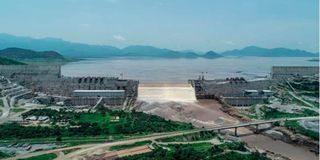Explainer: All about Ethiopia's controversial mega-dam

The Blue Nile Falls in Northern Ethiopia.
Ethiopia's construction of a massive dam on a tributary of the Nile River, which the UN Security Council meets about on Thursday, is raising regional tensions notably with Egypt, which depends on the Nile for 97 per cent of its water supply.
Ten countries

The Blue Nile Falls in Northern Ethiopia.
At 6,695 kilometres (4,160 miles), the Nile is one of the world's longest rivers and a crucial supplier of water and hydropower in a largely arid region.
Its drainage basin of more than three million square kilometres (1.16 million square miles) covers 10 countries: Burundi, Democratic Republic of Congo, Egypt, Ethiopia, Kenya, Rwanda, South Sudan, Sudan, Tanzania and Uganda.
The two main tributaries -- the White Nile and the Blue Nile -- converge in Khartoum before flowing north through Egypt and into the Mediterranean Sea.
Around 84 billion cubic metres of water is estimated to flow along the Nile every year.
Africa's biggest dam

An aerial view Grand Ethiopian Renaissance Dam on the Blue Nile River in Guba, northwest Ethiopia.
Ethiopia in 2011 launched construction of the Grand Ethiopian Renaissance Dam on the Blue Nile, roughly 30 kilometres from the border with Sudan.
The $4.2-billion dam will produce more than 5,000 megawatts of electricity, making it Africa's biggest hydroelectric dam and doubling Ethiopia's electricity output.
Ethiopia began the first phase of filling the reservoir for the 475-foot (145-metre) dam in mid-2020.
Egyptian thirst
Egypt, an arid nation of nearly 100 million people, depends on the Nile for most of its water needs, including for agriculture.
Cairo claims a historic right to the river dating from a 1929 treaty between Egypt and Sudan represented by colonial power Britain, that gave Egypt veto power over construction projects along the river.
A 1959 treaty boosted Egypt's allocation to around 66 percent of the river's flow, with 22 percent for Sudan.
Ethiopia was not party to those treaties and does not see them as valid.
In 2010 Nile basin countries, excluding Egypt and Sudan, signed another deal, the Cooperative Framework Agreement, that allows projects on the river without Cairo's agreement.
Flashpoint
Ethiopia, one of Africa's fastest growing economies in recent years, insists the dam will not affect the onward flow of water.
But Egypt fears its supplies will be reduced during the time it takes to fill the 74-billion-cubic-metre capacity reservoir.
Egypt considers the dam as a threat to its existence and Sudan has warned millions of lives will be at "great risk" if Ethiopia unilaterally fills the dam.
A decade of negotiations have failed to result in a deal.
Earlier this week, Egypt and Sudan said Ethiopia had started the second phase of filling the reservoir, an operation as yet not confirmed by Addis Ababa.
The Security Council meeting on Thursday was requested by Tunisia on behalf of Egypt and Sudan.
Tigray tensions
Another source of regional tension is the conflict since November in Ethiopia's northern Tigray region, which has sent some 60,000 refugees fleeing into Sudan, a nation struggling with its own economic woes.
The Sudanese and Ethiopian armies have recently remilitarised the fertile Fashaga border region where Ethiopian farmers have long cultivated land claimed by Sudan.





